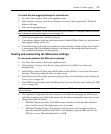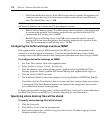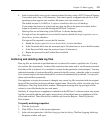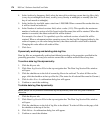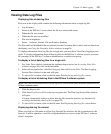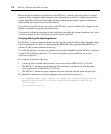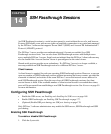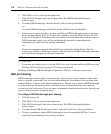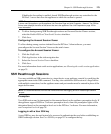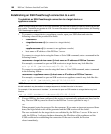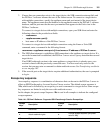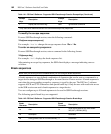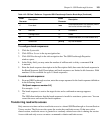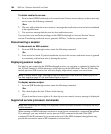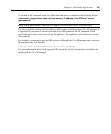
Chapter 14: SSH Passthrough Sessions 179
If hub/spoke forwarding is enabled, shared SSH Passthrough sessions are centralized to the
DSView 3 server that owns the appliance to which the session is opened.
NOTE: The appliance is owned by the DSView 3 server to which it was first added. To determine which DSView
3 server owns an appliance, go the appliance Unit Overview Page and click Properties - Network. The DSView
Server menu displays the name of the server that owns the appliance. See Unit Properties on page 125 for
more information.
6. To allow sharing among SSH Passthrough sessions and Avocent Session Viewer sessions,
select the Enable DSView Client Serial Sessions checkbox.
7. Click Save.
Configuring the Avocent Session Viewer
To allow sharing among sessions initiated from the DSView 3 client software, you must
preconfigure the Avocent Session Viewer as the serial viewer.
To configure the Avocent Session Viewer:
1. Click the Profile tab.
2. Click Applications in the side navigation bar.
3. Select the Avocent Session Viewer checkbox.
4. Click Save.
For more information about serial session applications, see Choosing the serial session application
on page 35.
SSH Passthrough Sessions
You may establish an SSH connection to a target device or an appliance console by specifying the
appropriate name in the SSH command. You may also establish an SSH session to a target device
with multiple connections, but the appliance name and port number must be entered in place of the
target device name.
NOTE: It is recommended that no more than 2048 concurrent data logging and SSH Passthrough sessions
be open.
Preemption
Your SSH session may be interrupted or disconnected based on the appliance preemption levels. If
the appliance supports DSView 3 software preemption levels, then user preemption rights will be
determined based on the preemption levels set in the DSView 3 software. For more information,
see Preemption Levels on page 38.
Logging in with a User SSH key
A user SSH key may be used instead of a password to authenticate the user before establishing an
SSH Passthrough session. See User SSH key on page 207 to configure the key.



